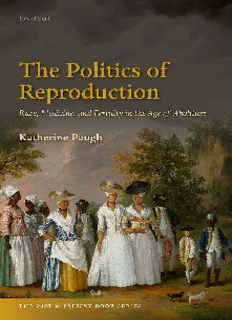
Politics of reproduction : race, disease, and fertility in the age of abolition PDF
Preview Politics of reproduction : race, disease, and fertility in the age of abolition
THE PAST & PRESENT BOOK SERIES GeneralEditor PETER COSS The Politics of Reproduction The Politics of Reproduction Race, Medicine, and Fertility in the Age of Abolition KATHERINE PAUGH 1 3 GreatClarendonStreet,Oxford,OX26DP, UnitedKingdom OxfordUniversityPressisadepartmentoftheUniversityofOxford. ItfurtherstheUniversity’sobjectiveofexcellenceinresearch,scholarship, andeducationbypublishingworldwide.Oxfordisaregisteredtrademarkof OxfordUniversityPressintheUKandincertainothercountries ©KatherinePaugh2017 Themoralrightsoftheauthorhavebeenasserted FirstEditionpublishedin2017 Impression:1 Allrightsreserved.Nopartofthispublicationmaybereproduced,storedin aretrievalsystem,ortransmitted,inanyformorbyanymeans,withoutthe priorpermissioninwritingofOxfordUniversityPress,orasexpresslypermitted bylaw,bylicenceorundertermsagreedwiththeappropriatereprographics rightsorganization.Enquiriesconcerningreproductionoutsidethescopeofthe aboveshouldbesenttotheRightsDepartment,OxfordUniversityPress,atthe addressabove Youmustnotcirculatethisworkinanyotherform andyoumustimposethissameconditiononanyacquirer PublishedintheUnitedStatesofAmericabyOxfordUniversityPress 198MadisonAvenue,NewYork,NY10016,UnitedStatesofAmerica BritishLibraryCataloguinginPublicationData Dataavailable LibraryofCongressControlNumber:2016949066 ISBN 978–0–19–878978–9 Printedandboundby CPIGroup(UK)Ltd,Croydon,CR04YY LinkstothirdpartywebsitesareprovidedbyOxfordingoodfaithand forinformationonly.Oxforddisclaimsanyresponsibilityforthematerials containedinanythirdpartywebsitereferencedinthiswork. To my parents, Jon and Roberta Paugh, who taught me to read and write, and to my Uncle Phil, who taught me to gamble... Acknowledgments Ihaveincurredmanydebts,bothintellectualandpractical,duringtheyearsIspent writing this book. I have been fortunate to receive a number of grants and fellowshipsthatsupportedtheresearchandwritingofthisbook.Fortheirfinancial support, I should like to thank the University of Pennsylvania, the Library Company of Philadelphia, the North American Conference on British Studies, the McNeil Center for Early American Studies, the Gilder Lehrman Institute, the HarvardInternationalSeminarontheHistoryoftheAtlanticWorld,theAmerican Philosophical Society, the Huntington Library, and the University of Wisconsin- Milwaukee. Inpreparingthisbook,Ihavebenefitedfromthegenerousassistanceofarchivists at institutions in the United States, the Caribbean, and Great Britain. I would therefore like to extend thanks to the archivists at the Library Company of Philadelphia, the American Philosophical Society, the Philadelphia College of Physicians,theNewYorkHistoricalSociety,theHuntingtonLibrary,theBarbados Department of Archives, the Barbados Public Library, the University of the West Indies-Cave Hill, the British Library, the School of Oriental and African Studies (University of London), the National Archives of Great Britain, the Bodleian and Rhodes House Libraries (Oxford University), the York Minster Library, the NationalArchivesofScotland,andtheUniversityofEdinburgh. This book began as a dissertation at the University of Pennsylvania, and bene- fited from the guidance of faculty mentors who taught me how history is made: Daniel Richter, Kathleen Brown, Michael Zuckerman, Drew Faust, and Sheldon Hackney all deserve special thanks. Daniel Richter, in particular, has offered unfailingly patient advice over the years on matters both historical and practical, has helped me immensely as a writer, and has served as a role model of generous mentorship, not only for myself, but for a generation of early Americanists. I am also very grateful to Mary Fissell for her sage advice—she was bound by no institutional obligation, but has nonetheless offered many years of advice and intellectual guidance during my graduate training and early career, out of sheer scholarly generosity. Special thanks go also to Kathleen Wilson, who has offered thoughtful advice and mentoring that was crucial to the evolution of the book manuscript. A number of scholars have also improved this book immeasurably with their comments, including Roderick McDonald, Steve Hindle, Philip Morgan, Chris Brooks, Merry Wiesner-Hanks, Ellen Amster, Bruce Fetter, and JeromeHandler. I have presented portions of this book in a number of public venues, including seminarsandcolloquiaattheUniversityofNewcastle,theUniversityofCalifornia atDavis,theHuntingtonLibrary,theUniversityofSouthernCalifornia,theState University of New York at Buffalo, Virginia Commonwealth University, the University of Wisconsin-Milwaukee, the McNeil Center for Early American viii Acknowledgments Studies, the University of York, Johns Hopkins University, the University of Pennsylvania, and the University of California at Santa Cruz, and also at annual meetings of the Association of Caribbean Historians, the American Historical Association, the Society of Early Americanists, and the American Society of Eighteenth-Century Studies. I would like to thank the participants for their very helpfulcommentsandsuggestions. Portions of this book have appeared previously as journal articles. An early meditation on the subject of this book appeared in Past & Present in 2013. ApreliminaryversionofChapter2appearedinSlavery&Abolitionin2014.Portions of Chapter4 appeared in the Bulletin of the History of Medicine, also in 2014. I am indebtedtotheeditorsandanonymousreadersatthesejournalsfortheirguidance. Ihavebaskedintheintellectualcamaraderieofanumberoffellowscholarsover theyears.Ihadtheopportunitytoengagewithalivelycommunityofscholarsinmy fieldattheMcNeilCenterforEarlyAmericanstudiesduringtheyearsIhungmy hat there, including Yvie Fabella, Heather Kopelson, Matthew Garrett, Hunt Howell,YvettePiggush,LauraSpero,PatrickSpero,AndrewLipman,KyleRoberts, Michelle McDonald, Catherine Kelly, Brian Connolly, Simon Finger, Jessica Lepler, Jared Richman, and Ken Cohen, among many others. During the year IspentrevisingthisbookattheHuntingtonLibrary,Ifoundanequallystimulating intellectual community with Cynthia Nazarian, Paul Ramirez, Michele Navakas, Carol Pal, Lindsay O’Neill, and Jason Sharples. I owe a special debt to my fellow graduate students at the University of Pennsylvania, who inspired me with their determinationthroughthetrialsofcomprehensiveexamsanddissertationdefenses, including Julia Rabig, Jen Schaaf, Nick DiLiberto, Todd Wolfson, Vanessa Mongey, Gregory Wolmart, Paul Burnett, Mate Tokic, Sarah Van Beurden, Joe Drury,DeirdreBrill,AndrewHeath,TehyunMa,andTinaCollins.Iwouldliketo express my gratitude, also, to the wonderful students and colleagues I have had the pleasureofworkingwithattheinstitutionsatwhichIhavetaughtduringthewriting ofthisbook:theUniversityofWisconsin-Milwaukee,SarahLawrenceCollege,and the University of Pennsylvania. I am particularly grateful to my cohort in the Department of History at the University of Wisconsin-Milwaukee: Christine Evans, David DiValerio, Winson Chu, Lisa Silverman, and Marcus Filippello have provided tremendous support and encouragement during the latter stages of writingthisbook. This book could not have been written without the encouragement of friends and family along the way. Thanks to Fatima Patel, Dillon Brown, Maria Landa Buil, JairoSánchezGalvis,Elisabeth Bladh, Melanie Newton,Alejandra Coy, and Anthony Matthews for making me feel at home abroad. Thanks to Rachel Steele, AmyAltmiller,andJohnMcCoy,myoldestanddearestfriends.Ialsoofferheremy love and thanks to my brother and sister, Jon and Rachel Paugh, my fond remem- brancetomyparentsJonandRobertaPaughandmyunclePhilZebrakus,maythey restinpeaceknowingthatIfinallyfinishedthebookthattheydidnotlivetoseebut alwaysbelievedin,andfinallymygratitudetomysonFelix,whosearrivalgracedme withadelightfulandnon-negotiableincentivetobringthisprojecttoaclose. Contents ListofFiguresandTables xi Introduction 1 1. “TheOldSettlersHaveBredaGreatQuantityofSlaves”:Slavery, Reproduction,andRevolution,1763–97 23 2. TheCuriousCaseofMaryHylas:Wives,Slaves,andtheLimits ofBritishAbolitionism 55 3. ConceivingFertilityintheAgeofAbolition:Slavery,Sexuality, andthePoliticsofMedicalKnowledge 85 4. AWestIndianMidwife’sTale:ThePoliticsofChildbirth onNewtonPlantation 122 5. “AnIncreasingCapitalinanIncreasingGang”:Governing Reproduction,1798–1838 154 6. Missionaries,Madams,andMothersinBarbados 190 Afterword 232 Bibliography 239 Index 255
Description: